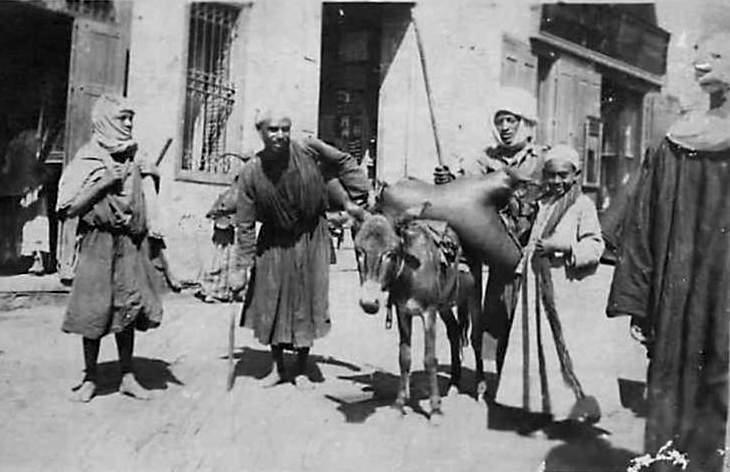
Animals and History: The Donkey

Figure 1.--This Cairo street scene was probably taken in the 1930s. It shows how indespensible the donkey was to people. This donkey looks to be carrying a goat skin, probably filled with water. This same sceen could have occurred on the same street virtually unchanged a millenium earlier if not even earlier. Thiis leads to a fascinating question. How could a crossroad country be litteraly frozen in time for such an extended period.
|
|
The donkey (burro) and camel proved valuable beasts of burden making trade possible over distances like the Silk Road. The donkey was the first beast of burden, millenia bfore the camel. The humble donkey may be thd most underappreciated of all animls. Not only was the donkey important in agriculture and trade, it was commonly unappreciated as a vital animal in warfare. The donkey actually made war, as opposed to localized raiding, possible. An army of any size could not move any significan distance without a way of transporting weapons, food, water, and other supplies. And the donkey provided a way to move these supplies. Geneticists believe that wild asses (Equus africanus asinusin) of northeast Africa which inhabited what is now Somalia and Sudan (Nubia) are the ancestors of modern donkeys. The humble donkey was vital in the spread of commerce and trading which also meant the spread and sharing of ideas. These animals appear to have been captured and domesticated in Egypt and western Asia (Mesopotamia) (around 2800-2500 B.C.). This was, however, just the beginning. It took another millenium that the donkey became the common means of transportation through the Old World (1000 BC). We know about the domestication of donkeys because it occured so early, perhaps about 3000 BC. Archaeological finds and ancient art tell us little until anout this time. King Tutankhamen's tomb contained depictions of wild ass hunts. Donkeys were used for a great range of purposes by ancient people. The animals were first hunted and then domesticated. Once domesticated They provided a means of transportation for agricultural goods, humans, and trade goods. The donkey was the firt beast of burden available to ancient people. Humans crossed the Bearing Sea Ice Bridge before donkeys were domesticated. Native amercans thus had to develop thir civilizations without beast of burden. Andean people du have the llama, but it could carry realtively small loads and away from the Andes there was no beast of burden at all. Eventually horses were bred with donkeys, producing the mule an animal capable of much grater loads than the donkey. Donkeys found their way to the New World through the voyage of Christopher Columbus. He aided in the migration of these animals when he brought four males and two females to America. Once in the Americas, they were bred and produced mule offspring. The mules were used by the Spanish throughout their conquests. It was not until the gold rush that donkeys become increasingly important in America. During this time, donkeys were used for a variety of purposes. including hauling gold and silver across mountainous teraine so it could be shipped back to Spain and to China. The donkey was so useful that it continued to be used as a beast of burden into the 20th century. Amazingly, the Arab World as late as World War II looked much like biblical times with the donkey still being hused as a beast of burden.
CIH

Navigate the Children in History Website:
[Return to the Main animal page]
[Introduction]
[Biographies]
[Chronology]
[Climatology]
[Clothing]
[Disease and Health]
[Economics]
[Geography]
[History]
[Human Nature]
[Law]
[Nationalism]
[Presidents]
[Religion]
[Royalty]
[Science]
[Social Class]
[Bibliographies]
[Contributions]
[FAQs]
[Glossaries]
[Images]
[Links]
[Registration]
[Tools]
[Children in History Home]
Created: 8:19 PM 9/3/2014
Last updated: 8:19 PM 9/3/2014



